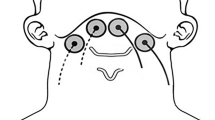Abstract
Swallowing disorders are a common complaint among the elderly. Recently, surface electrical stimulation applied to the neck region has received increased attention as a new modality to treat pharyngeal dysphagia. Previous reports used pulsed current at a frequency range of 1-120 Hz. Kilohertz-frequency alternating currents (ACs) have not been tested for treating dysphagia. Therefore, we evaluated the effects of interferential currents (IFCs), the most popular modality of amplitude-modulated kilohertz-frequency ACs in clinical practice, on the swallowing reflex in healthy subjects. We found that IFC stimulation at the sensory threshold with 50-Hz modulation significantly increased the number of swallows without any discomfort, but pure AC stimulation at the carrier frequency did not have a significant effect. There was no statistically significant difference in the time course of the number of swallows among 1,000-, 2,000-, 4,000-, and 6,000-Hz carrier frequencies. The number of swallows remained increased during the 15-min IFC stimulation, suggesting that IFC stimulation facilitates the swallowing reflex without adaptation, at least during this stimulation period. We suggest that an IFC stimulation or a low-frequency, modulated kilohertz AC stimulation, which would be more comfortable than pulsed currents, is an alternative stimulation mode for treating pharyngeal dysphagia.





Similar content being viewed by others
References
Shamburek RD, Farrar JT. Disorders of the digestive system in the elderly. N Engl J Med. 1990;322:438–43.
Martino R, Foley N, Bhogal S, Diamant N, Speechley M, Teasell R. Dysphagia after stroke: incidence, diagnosis, and pulmonary complications. Stroke. 2005;36:2756–63.
Byrne K, Pfeiffer R, Quigley E. Gastrointestinal dysfunction in Parkinson’s disease: a report of clinical experience at a single center. J Clin Gastroenterol. 1994;19:11–6.
Freed ML, Freed L, Chatburn RL, Christian M. Electrical stimulation for swallowing disorders caused by stroke. Respir Care. 2001;46:466–74.
Bulow M, Speyer R, Baijens L, Woisard V, Ekberg O. Neuromuscular electrical stimulation (NMES) in stroke patients with oral and pharyngeal dysfunction. Dysphagia. 2008;23:302–9.
Ludlow CL, Humbert I, Saxon K, Poletto C, Sonies B, Crujido L. Effects of surface electrical stimulation both at rest and during swallowing in chronic pharyngeal dysphagia. Dysphagia. 2007;22:1–10.
Carnaby-Mann GD, Crary MA. Examining the evidence on neuromuscular electrical stimulation for swallowing—a meta-analysis. Arch Otolaryngol Head Neck Surg. 2007;133:564–71.
Ward AR. Electrical stimulation using kilohertz-frequency alternating current. Phys Ther. 2009;89:181–90.
Palmer ST, Martin DJ, Steedman WM, Ravey J. Alteration of interferential current and transcutaneous electrical nerve stimulation frequency: effects on nerve excitation. Arch Phys Med Rehabil. 1999;80:1065–71.
Cohen J. Statistical power analysis for the behavioral sciences. 2nd ed. Hillsdale, NJ: Lawrence Erlbaum; 1988.
Alon G, Allin J, Inbar GF. Optimization of pulse duration and pulse charge during transcutaneous electrical nerve stimulation. Aust J Physiother. 1983;29:195–201.
Ward AR, Robertson VJ. Sensory, motor, and pain thresholds for stimulation with medium frequency alternating current. Arch Phys Med Rehabil. 1998;79:273–8.
Jean A. Brain stem control of breathing: neuronal network and cellular mechanisms. Physiol Rev. 2001;81:929–69.
Oku Y, Tanaka I, Ezure K. Activity of bulbar respiratory neurons during fictive coughing and swallowing in the decerebrate cat. J Physiol Lond. 1994;480:309–24.
Kitagawa J, Nakagawa K, Hasegawa M, Iwakami T, Shingai T, Yamada Y, Iwata K. Facilitation of reflex swallowing from the pharynx and larynx. J Oral Sci. 2009;51:167–71.
Miller AJ, Lozzi RF. Anatomical and functional differentiation of superior laryngeal nerve fibers affecting swallowing and respiration. Exp Neurol. 1974;42:369–87.
Saito Y, Ezure K, Tanaka I. Difference between hypoglossal and phrenic activities during lung inflation and swallowing in the rat. J Physiol Lond. 2002;544:183–93.
Koga K, Furue H, Rashid MH, Takaki A, Katafuchi T, Yoshimura M. Selective activation of primary afferent fibers evaluated by sine-wave electrical stimulation. Mol Pain. 2005;1:13.
Ikari T, Sasaki CT. Glottic closure reflex: control mechanisms. Ann Otol. 1980;89:220–4.
Nemec H. Interferential therapy: a new approach in physical medicine. Br J Physiother. 1959;12:9–12.
Robertson VJ, Ward AR, Low J, Reed A. Electrotherapy explained. Principles and practice. 4th ed. Oxford, UK: Butterworth Heinemann; 2006.
Park CL, ONeill PA, Martin DF. A pilot exploratory study of oral electrical stimulation on swallow function following stroke: an innovative technique. Dysphagia. 1997;12:161–6.
Power M, Fraser C, Hobson A, Rothwell JC, Mistry S, Nicholson DA, Thompson DG, Hamdy S. Changes in pharyngeal corticobulbar excitability and swallowing behavior after oral stimulation. Am J Physiol Gastrointest Liver Physiol. 2004;286:G45–50.
Köklü S, Köklü G, Özgüçlü E, Kayani G, Akbal E, Hasçelik Z. Clinical trial: interferential electric stimulation in functional dyspepsia patients—a prospective randomized study. Aliment Pharmacol Ther. 2010;31:961–8.
Acknowledgments
The authors thank Prof. Y. Muraoka and Dr. T. Daimon, Department of Mathematics, Hyogo College of Medicine, Nishinomiya, Hyogo, Japan, for their valuable comments on statistical methods.
Author information
Authors and Affiliations
Corresponding author
Rights and permissions
About this article
Cite this article
Furuta, T., Takemura, M., Tsujita, J. et al. Interferential Electric Stimulation Applied to the Neck Increases Swallowing Frequency. Dysphagia 27, 94–100 (2012). https://doi.org/10.1007/s00455-011-9344-2
Received:
Accepted:
Published:
Issue Date:
DOI: https://doi.org/10.1007/s00455-011-9344-2




